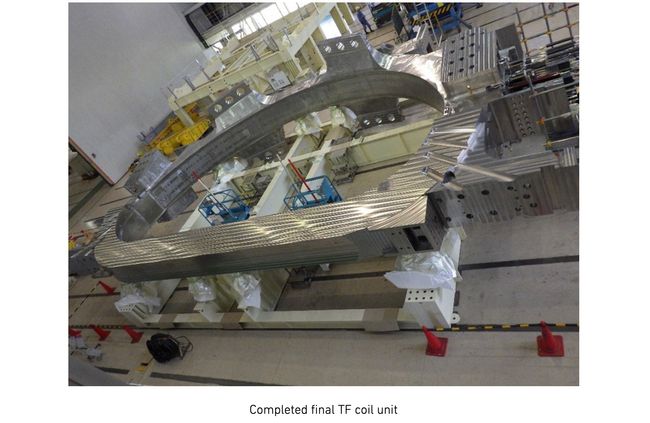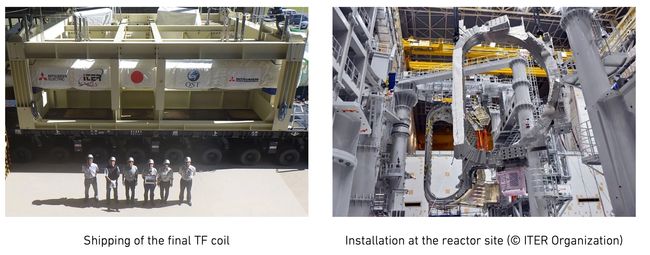PUBLISHED ONAugust 24, 2023 7:58 AM

 |
 |
The TF coils for ITER are massive superconducting coils, 16.5 meters high and 9 meters wide with a gross weight of 300 tonnes each, and require a manufacturing accuracy of within 0.01% to initiate a fusion reaction in the reactor. MHI completed the world's first TF coil for ITER in January 2020 by bringing together the extensive knowledge it has cultivated over the years regarding mass production technologies for products with a high degree of manufacturing difficulty. The four TF coils already completed have been successively shipped from the port of Kobe to southern France, and are being installed at the construction site. This latest unit is schedule for shipment from Kobe this month.
In addition to the TF coils, MHI is also working on the development and manufacturing of other core components, including the divertor(Note1) and equatorial EC launcher(Note2). MHI will continue to contribute to the realization of fusion energy by actively supporting the design and development of the fusion prototype reactors that are planned to be built following the ITER project.
Reference Material
Project Background
The ITER Project is an international megaproject aimed at demonstrating, both scientifically and technologically, the realization of fusion energy(Note3). Seven parties are participating (Japan, the EU, the U.S., Russia, South Korea, China, and India), with construction of ITER underway in Saint-Paul-les-Durance, France. Japan is playing a major role in developing and manufacturing the core components of ITER, including the TF coils. QST, as the ITER Japan domestic agency for the ITER Project designated by Japanese Government, oversees procurement of these components.
ITER's superconducting TF coils are D-shaped and approximately 16.5m in height, 9m wide, and weigh some 300 tonnes. Eighteen TF coils will encompass the vacuum vessel container and generate a powerful magnetic field (maximum of 12 tesla) to confine high-temperature, high-density plasma within the vessel. The ITER Project requires a total of 19 TF coils (including one spare). Nine are being made in Japan (including the spare) and 10 in Europe. The inboard coil structures for all 19 TF coils will be manufactured at MHI's Futami Plant. Mitsubishi Electric Corporation is manufacturing the niobium-tin (Nb3Sn) superconducting winding packs for the five TF coils (including the spare) built in Japan, with the outboard coil structures being manufactured in South Korea, with final assembly at the Futami Plant.
Significance of This Latest Achievement
A highly precise, strong magnetic field (12 tesla) is required to confine plasma inside ITER, necessitating the development of unprecedentedly large superconducting coils that use niobium-tin conductors. To maintain superconductivity, the coils must be able to function in cryogenic temperatures of minus 269degC, which required the development of special stainless steel structural materials capable of withstanding such low temperatures, along with all the requisite manufacturing technology. Not only was there no precedent for coils of this unsurpassed scale, the dimensional tolerances of the windings and coils required a high precision of within 0.01%.
QST commenced R&D for the TF coil manufacturing technology in 2005, and MHI began their manufacture in 2012. Working in collaboration, QST and MHI developed high-precision technology for winding niobium-tin conductors, as well as durable structural materials made from a special stainless steel capable of withstanding cryogenic temperatures. Further, to determine the manufacturing methods to suppress deformations caused by welding, parameter tests were conducted, and the welds verified using both miniature and full-scale specimens, which formed the basis for the fundamental technologies suited to the material's properties, including advanced welding procedures and machining techniques. Ultimately, MHI was able to meet the stringent requirements demanded for ITER.
(1) The divertor is a device to remove impurities in the core plasma, as well as inhibit high heat load and particle loading.
(2) The equatorial EC launcher is a device to inject high-frequency electromagnetic waves to heat the plasma.
(3) Fusion is the energy source that enables the sun to keep shining, and the ultimate goal is achieving fusion on Earth. Fusion reactions fuse light atomic nuclei (deuterium and tritium) in a plasma environment into the heavier element of helium. Fusion reactions emit zero carbon dioxide, and their source of fuel can be extracted from seawater in virtually unlimited quantities (lithium from which tritium is derived, and deuterium). Fusion energy is expected to provide fundamental solutions to many of the world's energy and environmental problems.
About MHI Group
Mitsubishi Heavy Industries (MHI) Group is one of the world's leading industrial groups, spanning energy, smart infrastructure, industrial machinery, aerospace and defense. MHI Group combines cutting-edge technology with deep experience to deliver innovative, integrated solutions that help to realize a carbon neutral world, improve the quality of life and ensure a safer world. For more information, please visit www.mhi.com or follow our insights and stories on spectra.mhi.com.
Copyright 2023 JCN Newswire. All rights reserved. www.jcnnewswire.com

